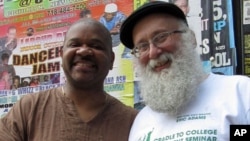The James E. Davis Multicultural Museum of Peace in Brooklyn, New York is a storefront shrine to dialog and reconciliation. So it's both ironic and appropriate that it stands mere meters away from the spot where the child of two West Indian immigrants was accidentally killed by a car driven by an Orthodox Jew from the Chabad Hasidic sect, whose world headquarters are a mere block away.
The incident sparked three days of violence in 1991 that pitted the area's African American and Caribbean communities against the area's sizable Orthodox Jewish population. It resulted in a young Jew being killed in reprisal, and millions of dollars worth of property destroyed in the city's Crown Heights neighborhood.
Named after James E. Davis, the late African American New York City councilman and co-founder of the "Love Yourself Stop the Violence" organization, the museum's walls are covered in photos in his honor in hopes of educating people on the importance of standing together against violence.
According to longtime resident Betty Bogan, the so-called "Crown Heights Riots" gave vent to long standing grievances by many African American and Caribbean community members.
"It was the youth taking matters into their own hands, voicing by their behavior the disrespect that they felt," Bogan says.
Bogan adds that many felt they had been denied proper access to community services - such as the Jewish community's private ambulance that might have saved the boy.
Some claimed they had been exploited by Jewish businesses. According to her, this is where James Davis made his contribution.
"He loved people, and he wanted to co-exist in a respectful way," she says.
While the riots were still raging, local officials invited leaders from all three communities to air their differences and explore solutions together. James Davis' brother Geoffrey Davis, who founded and runs the peace museum, says that the Crown Heights Coalition that arose and his brother shared one basic message: Cooperation is in everyone's interest.
"While the community itself was outraged, the leadership had to kick in now [saying] 'we've got to get a structured plan to talk to these different people [involved]," Davis says.
For example, one coalition member may have had the trust of young African Americans, so he would reach out to them, while a certain rabbi had the ear of Jewish senior citizens.
"And it worked!" Davis says, with an enthusiasm undiminished by the years.
Concrete results from those efforts include a "safe streets" partnership between the city police, the African American and Caribbean communities, and "Shmira" an all volunteer street patrol that was exclusively Jewish before the riots.
"They asked me to join them and walk with them at night to secure the neighborhood," Davis says. "It's not just Hasidic [anymore]; it's multicultural."
Davis is especially proud of the Crown Heights Community Mediation Center, a project co-sponsored by grassroots groups like his and umbrella organizations such as the Crown Heights Jewish Community Council. All stakeholders work closely together to resolve conflicts both between and within community groups. "That wouldn't have happened in the 1990s!" he says.
Neighborhood leaders may have seen the necessity for inter-group dialog and cooperation early on, but many everyday people had to be brought into the process slowly.
Rueven Lipkind, a Hasidic Jew who now works for the area's African American state senator, takes a break from unloading supplies for a Parenthood Empowerment Day to explain that it was the youth from the various groups that often led the way together - through fun.
"They started doing concerts and getting kids involved in dance and putting on shows and showing that people can work together, doing things together," Lipkind recalls. "Those joint activities demonstrated to the crowds that there can't be fighting. We can use our talents to work things out."
Lipkind says that all communities are slowly learning that far more unites them, than divides them.
"We're all really the same. We all have children. We all put our pants on in the same way. And everyone has the same kind of problems. And if you work together you have a lot more peace. Davis says. "And if he [Davis] wants to make a museum to that, that's great!"
An upcoming exhibit at the James E. Davis Multicultural Museum of Peace will feature the late Grand Rabbi of the Chabad Hasidic sect, and highlight his kindness and charity. Another will be dedicated to the Reverend Dr. Johnny Ray Youngblood, whose men's ministry has helped thousands to kick their drug addictions and offered them homes, and a third will be dedicated to the Jamaican reggae musician and peace activist Bob Marley.








